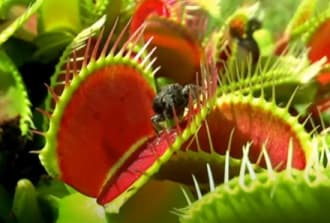As an Amazon Associate, this site earns commissions from qualifying purchases. For more details, click here.
Venus flytraps, with their captivating ability to catch prey, are among the most intriguing carnivorous plants. However, their unique allure also attracts pests, with spider mites being a common nuisance. These tiny arachnids can wreak havoc on Venus flytraps if left unchecked, causing leaf damage, stunted growth, and overall decline in plant health.
Key Takeaways:
- Spider mites pose a significant threat to Venus flytraps, causing leaf damage and stunted growth if left unchecked.
- Effective control strategies include pruning infested parts, introducing natural predators, and using horticultural oils or neem oil.
- Preventive measures such as quarantining new plants and regular monitoring are essential for early detection and management of spider mite infestations.
Why Spider Mites are Harmful to Venus Flytraps
Spider mites pose a significant threat to the health and well-being of Venus flytraps due to their destructive feeding habits and rapid reproduction. These tiny arachnids, barely visible to the naked eye, thrive in warm, dry environments and are adept at colonizing plants with their web-spinning abilities.
Once infested, spider mites pierce the plant’s tissue with their needle-like mouthparts and feed on the sap within. This feeding activity weakens the Venus flytrap, causing visible symptoms such as yellowing leaves, stippling, and the formation of fine webbing. These pests can also affect any Venus flytrap companion plants you may have.
The harm inflicted by spider mites extends beyond mere cosmetic damage. By draining the plant’s vital fluids, they weaken its structure and compromise its ability to photosynthesize effectively.
This not only stunts the plant’s growth but also diminishes its ability to capture prey using its unique trapping mechanisms. As spider mite populations multiply rapidly, infestations can quickly spiral out of control, overwhelming the plant’s defenses and leading to further deterioration.

Other Harmful Effects
Moreover, spider mites can transmit harmful pathogens, exacerbating the plant’s vulnerability to disease. Left untreated, severe spider mite infestations can ultimately result in the demise of Venus flytraps, depriving them of their ability to thrive in their natural habitat.
Spider mites are harmful to Venus flytraps because they weaken the plant, hinder its growth and development, interfere with its carnivorous capabilities, and increase its susceptibility to disease. Therefore, timely detection and effective management of spider mite infestations are essential to safeguard the health and vitality of these captivating carnivorous plants.
Are Your Venus Flytraps Infested?
Identifying spider mite infestations on Venus flytraps requires keen observation and attention to detail, as these tiny pests can easily evade detection with their minuscule size. Here are several key indicators to look for:
Visual Symptoms
Examine the leaves and stems of the Venus flytrap for signs of damage. Spider mite infestations typically cause yellowing or bronzing of the leaves, often starting from the lower leaves and progressing upward.
Look for tiny, speckled spots on the foliage, known as stippling, which occurs as a result of the mites’ feeding activity.
Check for the presence of fine webbing between leaves and along leaf veins, particularly on the undersides of leaves. This webbing is a telltale sign of spider mite infestation.
Use a magnifying lens or hand lens to closely inspect the plant for tiny, moving specks. Spider mites are typically reddish-brown or yellowish in color and may appear as tiny dots on the plant surface. Pay particular attention to the undersides of leaves, where spider mites often congregate and feed.
Spider mite feeding can cause distortion and curling of the leaves, as well as premature leaf drop in severe cases. Inspect the plant for these symptoms, especially during periods of active growth. Check for necrotic patches or brown spots on the leaves, which may indicate advanced stages of infestation and damage.
Behavioral Cues
Observe the plant for any unusual behavior, such as reduced vigor, wilting, or a decline in overall health. These may be indirect signs of spider mite infestation, particularly if other causes have been ruled out.
Compare the suspected infested Venus flytrap with healthy specimens to identify any discrepancies in appearance or behavior. Look for differences in leaf color, texture, and overall vitality between the infested and healthy plants.
By carefully assessing these key indicators, growers can effectively identify spider mite infestations on Venus flytraps and take appropriate measures to mitigate their impact. Early detection is crucial for preventing infestations from spreading and causing irreparable damage to these fascinating carnivorous plants.
Keeping Spider Mites Away
Pruning and Removal. Trimming and removing heavily infested leaves and stems is a fundamental strategy in controlling spider mites on Venus flytraps. By eliminating the most severely affected plant parts, growers can prevent the spread of spider mites to healthy areas. It’s crucial to dispose of the removed plant material in sealed bags to prevent reinfestation and the inadvertent spread of pests to other plants in the vicinity.
Natural Predators
Introducing natural predators such as predatory mites, ladybugs, or lacewings to the Venus flytrap habitat is an eco-friendly approach to controlling spider mite infestations. These beneficial insects prey on spider mites, effectively reducing their population without the use of chemical insecticides. By establishing a balanced ecosystem, growers can harness the power of nature to combat pest infestations and maintain plant health.
Horticultural Oils
Applying horticultural oils or insecticidal soaps is a targeted method for suffocating and killing spider mites on Venus flytraps. These oils coat the pests’ bodies, disrupting their respiratory system and ultimately leading to their demise.
It’s essential to ensure thorough coverage of the plant, including the undersides of leaves where spider mites often congregate. Following the manufacturer’s instructions diligently is paramount to avoid inadvertently damaging the plant’s delicate foliage.
Neem Oil
Neem oil, derived from the neem tree, is renowned for its natural insecticidal properties and effectiveness against spider mites. Diluting neem oil according to the package instructions and applying it to the affected plant parts using a spray bottle can help control spider mite infestations on Venus flytraps. Additionally, neem oil acts as a repellent, deterring future pest activity and providing residual protection against reinfestation.
Cultural Practices
Maintaining optimal growing conditions is essential for promoting the health and resilience of Venus flytraps against spider mite infestations. High humidity levels and adequate moisture help create an environment less favorable for spider mites, as they thrive in warm, dry conditions. Avoiding overcrowding of plants and providing proper air circulation can further mitigate the risk of infestations by reducing favorable habitats for pests.
Preventive Measures
Quarantine New Plants: Thoroughly inspecting new Venus flytrap acquisitions for signs of spider mites or other pests before introducing them to the collection is crucial. Quarantining new plants for a few weeks allows growers to monitor for any signs of infestation and prevent the inadvertent spread of pests to existing plants.
Regular Monitoring: Establishing a routine schedule for monitoring Venus flytraps for early signs of spider mite infestations is essential for timely intervention. Promptly addressing any issues that arise helps prevent the spread of pests and minimizes damage to the plants, ensuring their continued health and vitality.
Inspect new Venus flytrap acquisitions thoroughly for signs of spider mites or other pests before introducing them to your collection.
Quarantine new plants for a few weeks to monitor for any signs of infestation before integrating them into your garden. Establish a routine schedule for monitoring Venus flytraps for early signs of spider mite infestations. Promptly address any issues that arise to prevent the spread of pests and minimize damage to the plants.
Conclusion
Controlling spider mites on Venus flytraps requires a proactive and multifaceted approach that combines vigilant monitoring, cultural practices, and targeted interventions. By implementing the comprehensive strategies outlined in this guide, growers can effectively manage spider mite infestations and safeguard the health and vitality of their Venus flytrap specimens. With dedication and attention to detail, enthusiasts can enjoy thriving plants free from the damaging effects of these troublesome pests, ensuring their continued enjoyment of these captivating carnivorous wonders.

My fascination with carnivorous plants began many, many years ago with Venus Fly Traps. Now I am more than happy to impart what I know with other enthusiasts and those who are curious about meat eating plants.


